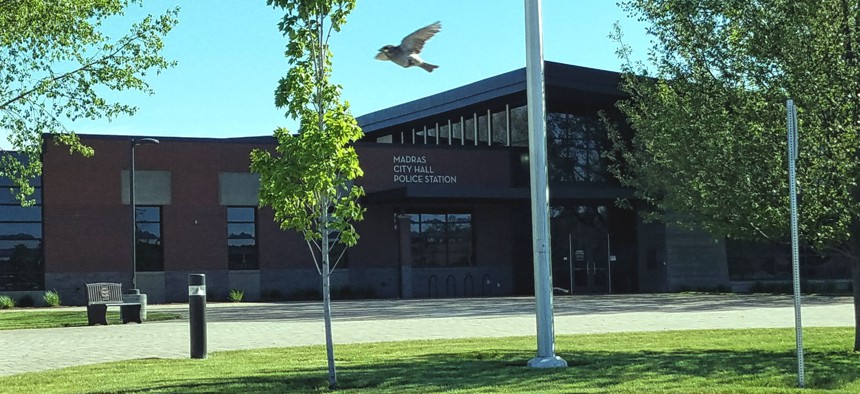When 100,000 People Suddenly Swarm a Rural City of 6,500 Residents

The municipal complex in Madras, Oregon Michael Grass / Route Fifty
Oregon expects 1 million visitors for the highly anticipated solar eclipse in August and Madras will play a starring role in managing the influx of people.
“The Geography of Disaster Risk and Resiliency in America” is an ongoing series of Route Fifty dispatches that's part of a larger forthcoming ebook providing snapshots of the very real dangers and disruptions that emergency planners, first responders, public officials and other stakeholders face, plus the strategies and technologies helping our communities be more resilient. | Previously: Morton, Washington
MADRAS, Ore. — This small city with 6,500 residents doesn’t usually come immediately to mind when you think about Oregon’s top tourist attractions. Much of central Oregon, including the region around Madras, is fairly unpopulated, which makes it surprising that lodging—or even a campsite—will be a very hot commodity come August.
A solar eclipse will cut a relatively narrow swath across North America on Aug. 21 and this part of Oregon is well positioned to see total eclipse conditions.
As many as 100,000 people are expected to flock to Madras, according to some estimates, and overall, the state anticipates that 1 million people will head into Oregon’s eclipse-viewing zone. The problem: Madras and many other places like it weren’t built to accommodate such an influx of visitors all at once.
As Bend-based KBND news radio station reported this week, the Madras Sanitary Service, which oversees waste management in and around the city, normally deals with 800-900 tons of trash over the course of a summer season. With August’s eclipse, there’s no telling how much waste will be produced by the onslaught of visitors, which will cause the local population to balloon to 10 times the size.
"For a once in a lifetime kind of thing, everyone is trying to cover all their bases," Melanie Widmer, the president of the Madras Sanitary Service, told KBND.
Complicating matters more: There aren’t that many main roads that cross central Oregon, so public safety officials will be dealing with congested traffic conditions.
The eclipse has prompted the Oregon Office of Emergency Management to issue an advisory for visitors and business owners.
For eclipse viewers, the state warns: “Be prepared for crowds, lines and traffic. Be patient. Bring books, games, etc., to keep busy; Take the time in long lines to get to know Oregonians and other visitors via lively conversation.” Also, pack an emergency kit and enough provisions.
And for business owners: “Grocery stores, gas stations, hotels, restaurants, transportation services, coffee shops, retail stores, urgent care clinics and many other establishments will experience a jump in business. We encourage them to order goods and schedule staff accordingly,” the state advises.
Going over the list of what to expect, there are other warnings: Cellphone service may be overloaded, there may be long lines to refuel gas, and people, whether they are welcome or not, will be searching for place to use a bathroom.
While the circumstances are different, some of the conditions visitors and locals will experience in Oregon’s eclipse-viewing zone won’t be all that dissimilar to those that will follow the Pacific Northwest's future Cascadia megathrust earthquake, whenever it strikes the region.
Following that monster quake and once U.S. Highway 26—the Mount Hood Highway—is cleared and reopened through the Cascade Range, displaced residents from Portland and elsewhere in the Willamette River, will be seeking refuge in central Oregon and beyond. And they will most likely pass through Madras, whether state and local officials are ready or not.
And with the Interstate 5 corridor wrecked by earthquake damage, U.S. Highway 97, the main north-south highway east of the Cascades, will be a critical inland transportation lifeline between Washington state and California. The route, inevitably, will be clogged with traffic.
“Prepare to shelter friends and families,” Deschutes County Sheriff’s Sgt. Nathan Garibay said during an emergency management discussion in October 2014, the Bend Bulletin reported at the time. “This is going to be a humanitarian event of epic proportions. You think Highway 97 is busy now, just you wait. There will be a massive influx of relief workers to central Oregon.”
The solar eclipse in August, if state and local emergency managers realize it or not, will be a good trial run for cities and counties in central Oregon that will someday, face an even larger influx of people into the region.
The major difference: The August solar eclipse has been on the calendar for a long time. An inevitable future Pacific Northwest megaquake will strike when it’s least expected.
Michael Grass is Executive Editor of Government Executive’s Route Fifty and is based in Seattle.
NEXT STORY: N.C. Man Sees $99.9 Million Service Fee on His Local Water Bill






